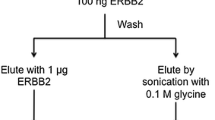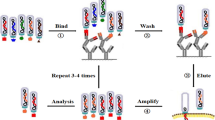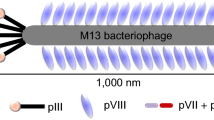Abstract
A novel peptide, BRBP1 (MYPWTEPSYLSN), was identified using an in vitro phage biopanning strategy against human brain-seeking breast carcinoma cells (231-BR cells).The peptide-phage clone, BRBP1-M13 displaying BRBP1 sequence, specifically bound to 231-BR cells and the binding could be competitively abolished by BRBP1. In vivo distribution studies showed that BRBP1-M13 preferentially homed to the 231-BR tumors. Fluorescently-labeled BRBP1, BRBP1-K(5-TAMRA), preferentially bound to 231-BR cells in a dose-dependent and energy-dependent manner and it was efficiently internalized into the cells after 2 h incubation. Near-infrared fluorophores imaging demonstrated the accumulation of Cy5.5-conjugated BRBP1 peptide in the tumors in vivo. Thus, BRBP1 is a promising peptide binding to human brain metastatic breast cancer and it may be applied to targeted delivery of cytotoxic agents to the intended tumor.





Similar content being viewed by others
References
Bignone PA, Krupa RA, Sternberg H, Funk WD, Snyder EY, West MD, Larocca D (2013) Identification of human embryonic progenitor cell targeting peptides using phage display. PLoS One 8:e58200. doi:10.1371/journal.pone.0058200
Cieslewicz M, Tang J, Yu JL, Cao H, Zavaljevski M, Motoyama K, Lieber A, Raines EW, Pun SH (2013) Targeted delivery of proapoptotic peptides to tumor-associated macrophages improves survival. Proc Natl Acad Sci USA 110:15919–15924
Ghosh D, Lee Y, Thomas S, Kohli AG, Yun DS, Belcher AM, Kelly KA (2012) M13-templated magnetic nanoparticles for targeted in vivo imaging of prostate cancer. Nat Nanotechnol 7:677–682
Hamann FM, Brehm R, Pauli J, Grabolle M, Frank W, Kaiser WA, Fischer D, Resch-Genger U, Hilger I (2011) Controlled modulation of serum protein binding and biodistribution of asymmetric cyanine dyes by variation of the number of sulfonate groups. Mol Imaging 10:258–269
Hatakeyama S, Sugihara K, Shibata TK, Nakayama J, Akama TO, Tamura N, Wong SM, Bobkov AA, Takano Y, Ohyama C, Fukuda M, Fukuda MN (2011) Targeted drug delivery to tumor vasculature by a carbohydrate mimetic peptide. Proc Natl Acad Sci USA 108:19587–19592
He X, Na MH, Kim JS, Lee GY, Park JY, Hoffman AS, Nam JO, Han SE, Sim GY, Oh YK, Kim IS, Lee BH (2011) A novel peptide probe for imaging and targeted delivery of liposomal doxorubicin to lung tumor. Mol Pharm 8:430–438
Larsen PB, Kumler I, Nielsen DL (2013) A systematic review of trastuzumab and lapatinib in the treatment of women with brain metastases from HER2-positive breast cancer. Cancer Treat Rev 39:720–727
Li J, Zhang Q, Pang Z, Wang Y, Liu Q, Guo L, Jiang X (2012) Identification of peptide sequences that target to the brain using in vivo phage display. Amino Acids 42:2373–2381
Liu H, Kato Y, Erzinger SA, Kiriakova GM, Qian Y, Palmieri D, Steeg PS, Price JE (2012) The role of MMP-1 in breast cancer growth and metastasis to the brain in a xenograft model. BMC Cancer 12:583. doi:10.1186/1471-2407-12-583
Nie F, Yang J, Wen S, An YL, Ding J, Ju SH, Zhao Z, Chen HJ, Peng XG, Wong ST, Zhao H, Teng GJ (2012) Involvement of epidermal growth factor receptor overexpression in the promotion of breast cancer brain metastasis. Cancer 118:5198–5209
Palmieri D, Bronder JL, Herring JM, Yoneda T, Weil RJ, Stark AM, Kurek R, Vega-Valle E, Feigenbaum L, Halverson D, Vortmeyer AO, Steinberg SM, Aldape K, Steeg PS (2007) Her-2 overexpression increases the metastatic outgrowth of breast cancer cells in the brain. Cancer Res 67:4190–4198
Preusser M, Berghoff AS, Schadendorf D, Lin NU, Stupp R (2012) Brain metastasis: opportunity for drug development? Curr Opin Neurol 25:786–794
Sturm MB, Joshi BP, Lu S, Piraka C, Khondee S, Elmunzer BJ, Kwon RS, Beer DG, Appelman HD, Turgeon DK, Wang TD (2013) Targeted imaging of esophageal neoplasia with a fluorescently labeled peptide: first-in-human results. Sci Transl Med 5:184ra161. doi:10.1126/scitranslmed.3004733
Weber GF (2008) Molecular mechanisms of metastasis. Cancer Lett 270:181–190
Yoneda T, Williams PJ, Hiraga T, Niewolna M, Nishimura R (2001) A bone-seeking clone exhibits different biological properties from the MDA-MB-231 parental human breast cancer cells and a brain-seeking clone in vivo and in vitro. J Bone Miner Res 16:1486–1495
Acknowledgments
This work was supported by National Basic Research Program of China (973 program) (2013CB733801), National Nature Science Foundation of China (81371609), and Research and innovation program of Jiangsu Province, China (CXLX12_0073).
Conflict of interests
None
Author information
Authors and Affiliations
Corresponding authors
Electronic supplementary material
Below is the link to the electronic supplementary material.
Rights and permissions
About this article
Cite this article
Fu, B., Zhang, Y., Long, W. et al. Identification and characterization of a novel phage display-derived peptide with affinity for human brain metastatic breast cancer. Biotechnol Lett 36, 2291–2301 (2014). https://doi.org/10.1007/s10529-014-1608-0
Received:
Accepted:
Published:
Issue Date:
DOI: https://doi.org/10.1007/s10529-014-1608-0




